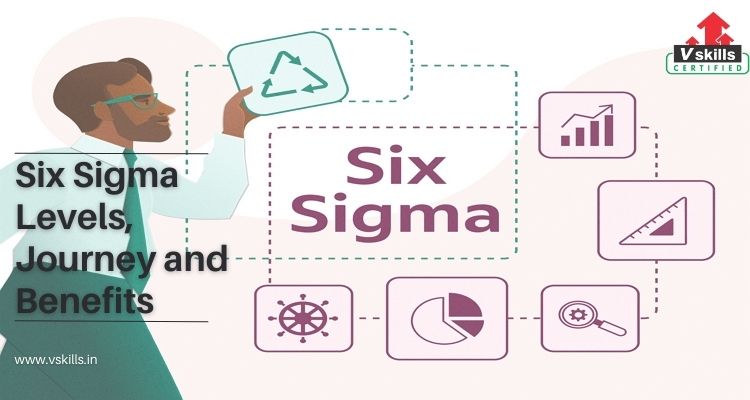In a world driven by efficiency and effectiveness, organizations constantly seek ways to improve their processes and reduce defects. Six Sigma, a data-driven methodology, has emerged as a potent tool for achieving these goals. Understanding the various levels of Six Sigma and its importance for your career can be a game-changer. This blog explores Six Sigma, its different levels, Six Sigma benefits and the profound impact it can have on your professional journey.
Understanding Six Sigma
Six Sigma is a disciplined, data-driven methodology focused on eliminating defects and variations in processes, products, and services. Developed by Motorola in the 1980s and popularized by General Electric, it has become a global standard for process improvement. The name “Six Sigma” is derived from the goal of reducing defects to fewer than 3.4 defects per million opportunities, which is equivalent to achieving a 99.99966% defect-free rate.
Six Sigma is based on two key methodologies: DMAIC (Define, Measure, Analyze, Improve, Control) and DMADV (Define, Measure, Analyze, Design, Verify). These methodologies guide the practitioner through a structured approach to problem-solving, process improvement, and product development.
Levels of Six Sigma
Six Sigma offers a structured hierarchy of certifications, each denoting a higher level of expertise and knowledge in the methodology. These levels are often represented using belts, similar to martial arts, signifying the practitioner’s proficiency. The most common levels of Six Sigma certification are:
White Belt: The White Belt level is a basic introduction to Six Sigma concepts. White Belt holders have a foundational understanding of the methodology but may not be actively involved in projects.
Yellow Belt: Yellow Belt holders have a deeper understanding of Six Sigma principles. They typically work as team members on projects, contributing to process improvement efforts.
Green Belt: Green Belt certification is for individuals who actively participate in Six Sigma projects and lead smaller projects. They have a solid understanding of the DMAIC methodology and are capable of analyzing and improving processes.
Black Belt: Black Belt holders are Six Sigma experts. They lead significant projects, mentor Green Belts, and have a comprehensive understanding of statistical tools and advanced problem-solving techniques.
Master Black Belt: Master Black Belts are the highest level of Six Sigma practitioners within an organization. They provide strategic leadership and mentorship to Black Belts and Green Belts. They are responsible for selecting and prioritizing Six Sigma projects and driving process improvement at an organizational level.
Champion: While not always considered an official Six Sigma belt, Champions are senior executives or leaders who play a critical role in defining the organization’s strategic direction for Six Sigma initiatives. They support and sponsor Six Sigma projects, ensuring alignment with the company’s goals.
The Importance of Six Sigma for Your Career
Now that we’ve discussed the different levels of Six Sigma, let’s delve into Six Sigma benefits and why Six Sigma is important for your career:
Enhanced Problem-Solving Skills: Six Sigma teaches a systematic approach to problem-solving, which is a valuable skill in any career. The ability to identify, define, measure, analyze, improve, and control processes is a universally applicable skill set.
Data-Driven Decision Making: Six Sigma is heavily reliant on data analysis. Gaining proficiency in statistical tools and data interpretation can help you make more informed decisions in your career, improving your problem-solving capabilities.
Improved Efficiency: By optimizing processes, Six Sigma reduces waste and inefficiency. This skill is valued in every industry, as organizations constantly seek ways to streamline operations and cut costs.
Quality Management: Quality is a key concern for businesses across various sectors. Six Sigma helps ensure high-quality products and services, enhancing your career prospects, especially if you’re involved in quality management or assurance.
Project Management: As you progress through Six Sigma levels, you gain project management skills. These are transferable skills that are valuable in almost any profession. Being able to plan, execute, and complete projects successfully is a key asset.
Leadership Opportunities: Advanced Six Sigma levels, such as Black Belt and Master Black Belt, often come with leadership roles. These positions involve leading teams, making strategic decisions, and driving change within the organization.
Competitive Advantage: A Six Sigma certification sets you apart in a competitive job market. Employers recognize the value of Six Sigma-trained professionals and are often willing to pay higher salaries for their expertise.
Cross-Functional Collaboration: Six Sigma projects often require collaboration across different departments and functions. Learning to work effectively with cross-functional teams can boost your career, as cross-functional collaboration is essential in most organizations.
Global Recognition: Six Sigma is a globally recognized methodology. Obtaining a Six Sigma certification can open doors to international career opportunities, especially in multinational corporations.
Continuous Learning: The Six Sigma journey never ends. There is always more to learn and improve upon. This commitment to lifelong learning and self-improvement is highly regarded by employers.
Industries that taking Six Sigma Benefits
Six Sigma is not limited to any specific industry. It can be applied effectively in a wide range of sectors, including:
Manufacturing: Six Sigma’s origins lie in manufacturing, where it was used to improve production processes, reduce defects, and increase product quality.
Healthcare: Healthcare organizations utilize Six Sigma to enhance patient care, reduce medical errors, and improve operational efficiency.
Service Industry: From hospitality to banking, Six Sigma is employed to enhance customer experiences, streamline processes, and reduce service defects.
Information Technology: IT companies use Six Sigma to improve software development processes, optimize infrastructure management, and deliver higher-quality solutions.
Financial Services: Banks and financial institutions employ Six Sigma to enhance transaction accuracy, reduce errors, and improve customer satisfaction.
Supply Chain and Logistics: Six Sigma helps organizations in this sector optimize supply chain processes, reduce inventory costs, and improve overall operational efficiency.
Aerospace: In aerospace and aviation, Six Sigma is used to enhance safety, reduce defects in critical systems, and ensure the highest level of quality.
Telecommunications: Telecom companies use Six Sigma to enhance network reliability, improve customer service, and reduce downtime.
Pharmaceuticals: In the pharmaceutical industry, Six Sigma is employed to ensure drug quality and safety, streamline research and development processes, and reduce time to market.
How to Start Your Six Sigma Journey for Six Sigma Benefits
If you’re interested in embarking on a Six Sigma journey to enhance your career and get Six Sigma benefits, here are the steps to get started:
Research and Choose a Level: Begin by researching the different levels of Six Sigma and selecting the one that aligns with your current knowledge and career goals. For beginners, Yellow Belt is a good starting point.
Training: Enroll in a reputable Six Sigma training program. You can find both online and in-person courses. These programs will teach you the methodology, tools, and techniques required to become proficient.
Certification: Upon completing your training, you’ll need to pass a certification exam to earn your Six Sigma belt. The certification is evidence of your knowledge and expertise in the methodology.
Apply Your Knowledge: Once you’ve earned your certification, look for opportunities to apply Six Sigma principles in your current job or in personal projects. Practical experience is invaluable. Six Sigma benefits accrue if practically applied.
Continuous Learning: As mentioned earlier, the Six Sigma journey is continuous. Consider pursuing higher-level certifications as you gain experience and confidence. Six Sigma benefits more if you move up to advanced levels.
Networking: Connect with other Six Sigma practitioners and professionals in your field. Networking can provide insights, support, and opportunities for collaboration.
Seek Career Advancement: Leverage your Six Sigma skills and certifications to advance your career. Look for positions that require or value Six Sigma expertise.
Conclusion
In a world where efficiency and quality are paramount, Six Sigma has emerged as a powerful methodology for process improvement and problem-solving. Whether you’re just starting your career or are a seasoned professional, Six Sigma can boost your career prospects. With different levels of certification, you can choose the path that best suits your goals and aspirations. By mastering Six Sigma, you’ll be equipped with valuable skills that are in demand across a wide range of industries, making you a highly sought-after professional in the job market. So, consider taking the first step on your Six Sigma journey today and unlock the potential for a more successful and rewarding career.




